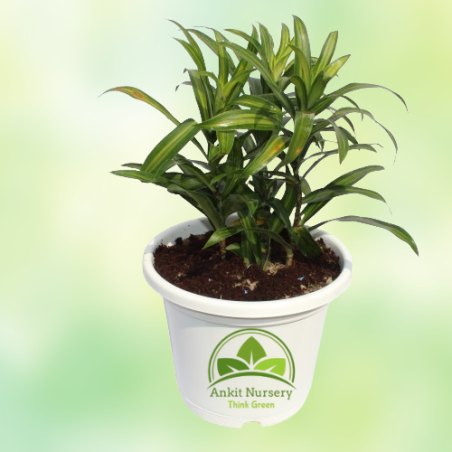
- -10%






The "Song of India" plant is a common name for the Dracaena reflexa var. angustifolia, a cultivar of the Dracaena reflexa species. This plant is known for its striking variegated foliage, which features green leaves with yellow or cream-colored margins. The Song of India plant has long, arching leaves that are typically lance-shaped and grow in clusters from a central stem.
In optimal conditions, Song of India plants can grow quite large, reaching heights of up to 6 feet or more. However, they can be pruned to maintain a more compact size if desired. Song of India plants prefer bright, indirect light. They can tolerate lower light conditions but may not grow as vigorously or produce as much variegation. Avoid placing them in direct sunlight, as this can scorch the leaves.
Keep the soil consistently moist but not waterlogged. Water the plant when the top inch of soil feels dry to the touch, and allow any excess water to drain away. It's essential to avoid letting the soil become soggy, as this can lead to root rot. Song of India plants prefer temperatures between 65-80°F (18-27°C) and moderate humidity levels. They can tolerate average indoor humidity but may benefit from occasional misting or placement near a humidifier, especially in dry indoor environments. Use a well-draining potting mix rich in organic matter, such as peat moss or compost. A mix formulated for houseplants or tropical plants works well for Song of India. Feed your Song of India plant with a balanced liquid fertilizer diluted to half strength every 4-6 weeks during the growing season (spring and summer). Reduce fertilization in fall and winter when growth slows.
Song of India plants can be propagated from stem cuttings. Take a cutting with several nodes, remove the lower leaves, and place it in a pot with moist potting mix. Keep the soil consistently moist until roots develop. The leaves are glossy and can be up to several inches long, with distinctive yellow or cream-colored margins.
Prune Song of India plants to control their size and shape and remove any dead or yellowing leaves. Regular pruning can help maintain a tidy appearance and encourage bushier growth. Song of India plants are toxic if ingested, so keep them out of reach of children and pets. The sap can also be irritating to the skin, so it's a good idea to wear gloves when handling the plant.
Overall, Song of India plants are attractive and relatively low-maintenance houseplants that can add a touch of tropical elegance to any indoor space. With proper care, they can thrive and be enjoyed for many years.
"Chlorophytum" plant, commonly known as the Spider Plant. Chlorophytum comosum, or Spider...
Kagzi Grafted Lemon Plant, also known as Citrus limon 'Kagzi' or 'Kagzi Nimbu,' is a popular...
Syngonium Green is another variety of Syngonium podophyllum, commonly known as the Arrowhead...
Hibiscus is a genus of flowering plants in the family Malvaceae, which is native to warm...
A water plant, also known as an aquatic plant or hydrophyte, is a type of plant that has...
Indoor plants are a great way to bring nature into your home, purify the air, and enhance your...
Red Sensation Cordyline, also known as Cordyline fruticosa 'Red Sensation' or Red Sensation...
Water plants, also known as aquatic plants or hydrophytes, are plants that have adapted to...
Lucky Bamboo (Dracaena sanderiana) is a popular and easy-to-care-for houseplant that is...
The Saplera plant, also known as Polyscias filicifolia, is a tropical tree native to Southeast...
Rubber Plant - White Pot is a popular and attractive houseplant known for its glossy, deep...
Syngonium Golden Plant is a cultivar of Syngonium podophyllum, commonly known as arrowhead...
Croton Petra, also known as Codiaeum variegatum 'Petra,' is a popular cultivar of the Croton...
The Araucaria plant, also known as the Norfolk Island Pine or simply Araucaria, is a...
Peace Lily (Spathiphyllum spp.) is a popular and widely grown houseplant known for its...
The term "Pink Syngonium" typically refers to a variety of Syngonium podophyllum, commonly...